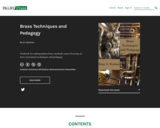
Textbook for undergraduate brass methods course focusing on brass instrument techniques and pedagogy.
- Subject:
- Arts and Humanities
- Performing Arts
- Material Type:
- Textbook
- Provider:
- PALNI Press
- Author:
- Brian Weidner
- Date Added:
- 05/27/2021

Browse OER Textbooks from the University of Minnesota's Open Textbook Library. These textbooks are authored and peer reviewed by faculty or other accredited subject matter experts. Many of these textbooks are actively used to teach OER based courses at instiutions across the United States.

Textbook for undergraduate brass methods course focusing on brass instrument techniques and pedagogy.
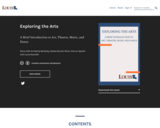
This text explores the visual and performing arts (art, music, dance, theatre).
Chapter 1: Elements, Vocabulary, and Iconography of Visual Art
Chapter 2: Mediums in Visual Art
Chapter 3: Ancient Arts (Prehistoric, Ancient Near East, Egyptian)
Chapter 4: Classical Period to Middle Ages
Chapter 5: Renaissance to Realism
Chapter 6: Impressionism to Modern
Chapter 7: An Introduction to the Theater and its Elements
Chapter 8: The Greek Origins of Western Theater
Chapter 9: Technical Theater
Chapter 10: The Actor's Craft
Chapter 11: Other Theater Traditions
Chapter 12: Introduction to Music
Chapter 13: Music in the Middle Ages and the Renaissance
Chapter 14: Baroque and Classical Music
Chapter 15: Music of the Romantic Era
Chapter 16: Music of the 20th Century
Chapter 17: Introduction to Dance
Chapter 18: Elements of Dance
Chapter 19: Dance History and Styles
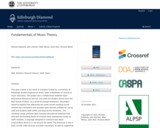
This open e-book is the result of a project funded by a University of Edinburgh Student Experience Grant, Open e-Textbooks for access to music education. The project was a collaboration between Open Educational Resources Service, and staff and student interns from the Reid School of Music. As a proof-of-concept endeavour, the project aimed to explore how effectively we could convert existing course content into convenient and reusable open formats suitable for use by staff and students both within and beyond the University. The resulting e-book presents open licensed educational materials that deal with the building blocks of musical stave (sometimes known as staff) notation, a language designed to communicate about musical ideas which is in use around the world. The resources in this e-book include video lectures and their transcripts, as well as supporting text explanations, examples and illustrations. The materials introduce topics such as the organisation of discrete pitches into scales and intervals, and temporal organisation of musical sounds as duration, in rhythm and metre. These rudiments are presented through an introduction to the elements of five-line stave notation, and through critical discussion of the advantages and limitations served by notational systems in the representation and analysis of musical sounds. This serves as the basis of further explanations, to illustrate musical concepts including key, time signature, harmonisation, cadence and modulation. We anticipate that subsequent versions of this e-book will update and develop the contents and presentation of the materials, following the success of this student-led collaboration.
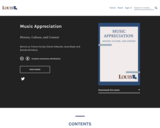
This text covers basic elements and vocabulary of music; appreciation and understanding of diverse styles of music past and present; developing listening skills. Includes opportunities for experiencing music (recorded and/or live).
I. Music Fundamentals
II. History of Western Music before 1600
III. History of Western Music after 1600
IV. Music of the 20th and 21st Centuries
V. Listening to Genres
VI. Music of Louisiana, the Americas, and the World
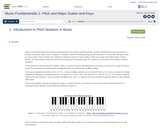
This collection is the first of five dealing with the rudiments of music.
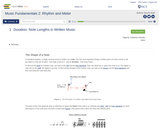
This collection is the second of five dealing with the rudiments of music.
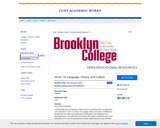
Welcome to Music 1300, Music: Its Language History, and Culture. The course has a number of interrelated objectives:
1. To introduce you to works representative of a variety of music traditions.These include the repertoires of Western Europe from the Middle Agesthrough the present; of the United States, including art music, jazz, folk, rock, musical theater; and from at least two non-Western world areas (Africa, Asia, Latin America, the Caribbean, the Middle East, Indian subcontinent).
2. To enable you to speak and write about the features of the music you study,employing vocabulary and concepts of melody, rhythm, harmony, texture, timbre,and form used by musicians.
3. To explore with you the historic, social, and cultural contexts and the role of class, ethnicity, and gender in the creation and performance of music,including practices of improvisation and the implications of oral andnotated transmission.
4. To acquaint you with the sources of musical sounds—instruments and voices fromdifferent cultures, found sounds, electronically generated sounds; basic principlesthat determine pitch and timbre.
5. To examine the influence of technology, mass media, globalization, and transnationalcurrents on the music of today.
The chapters in this reader contain definitions and explanations of musical terms and concepts,short essays on subjects related to music as a creative performing art, biographical sketchesof major figures in music, and historical and cultural background information on music fromdifferent periods and places.
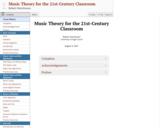
Music Theory for the 21st–Century Classroom is an openly–licensed online four–semester college music theory textbook. This text differs from other music theory textbooks by focusing less on four–part (SATB) voiceleading and more on relating harmony to the phrase. Also, in traditional music theory textbooks, there is little emphasis on motivic analysis and analysis of melodic units smaller than the phrase. In my opinion, this led to students having difficulty with creating melodies, since the training they are given is typically to write a “melody” in quarter notes in the soprano voice of part writing exercises. When the assignments in those texts ask students to do more than this, the majority of the students struggle to create a melody with continuity and with appropriate placement of harmonies within a phrase because the text had not prepared them to do so.
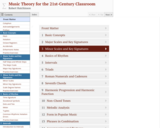
Music Theory for the 21st–Century Classroom is an openly–licensed online college music theory textbook that is meant to take the student from the basics of reading and writing pitches and rhythms through twelve–tone technique and minimalism over the course of four semesters. This text differs from other music theory textbooks by focusing less on four–part (SATB) voiceleading and more on relating harmony to the phrase. Also, in traditional music theory textbooks, there is little emphasis on motivic analysis and analysis of melodic units smaller than the phrase. Whenever possible, examples from popular music and music from film and musical theater are included to illustrate melodic and harmonic concepts, usually within the context of the phrase. Practice exercises (with answers), homework exercises, and practice tests are included.
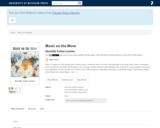
Music is a mobile art. When people move to faraway places, whether by choice or by force, they bring their music along. Music creates a meaningful point of contact for individuals and for groups; it can encourage curiosity and foster understanding; and it can preserve a sense of identity and comfort in an unfamiliar or hostile environment. As music crosses cultural, linguistic, and political boundaries, it continually changes. While human mobility and mediation have always shaped music-making, our current era of digital connectedness introduces new creative opportunities and inspiration even as it extends concerns about issues such as copyright infringement and cultural appropriation.

Original Études for the Developing Conductor is a collection of supplemental études designed to enhance contemporary conducting pedagogy by amplifying the voices of composers from historically excluded groups. Each étude was commissioned from and composed by a living composer, the majority of whom are woman-identifying composers and/or composers of color. Each étude also addresses multiple specific pedagogical goals common to all conducting classrooms.
Conducting textbooks commonly include musical examples to expose student conductors to various musical challenges and situations. However, due to the relative ease of using only music from the public domain, most examples found in commercially published books are excerpts of larger works composed by deceased cisgender white men of European descent. Often, this music bears little relation to a significant portion of the music contemporary students engage with and perform. These excerpts also tend to be quite short (i.e., less than a minute) and do not create cohesive, self-contained musical arcs.
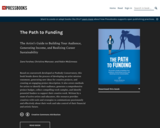
The Artist’s Guide to Building Your Audience, Generating Income, and Realizing Career Sustainability
Short Description:
Based on coursework developed at Peabody Conservatory, this book breaks down the process of developing an artist mission statement, generating new ideas for creative projects, and creating an engaging project description. It also covers methods for artists to identify their audience, generate a comprehensive project budget, collect compelling work samples, and identify potential funders to support their creative work. Written by a team of active artists and educators, this resource provides creatives with tools and strategies to communicate passionately and effectively about their work and take control of their financial and artistic future.
Word Count: 63170
(Note: This resource's metadata has been created automatically by reformatting and/or combining the information that the author initially provided as part of a bulk import process.)
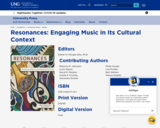
Welcome to Resonances: Engaging Music in Its Cultural Context! Although this book is intended primarily for use in the college music appreciation classroom, it was designed with consideration for independent learners, advanced high school students, and experienced musicians. That is to say, it includes enough detail that expert guidance is not required and is written using broadly-accessible language. At the same time, it addresses advanced topics and positions music as a serious object of study.

Sight-Reading for Guitar: The Keep Going Method Book and Video Series teaches guitar players from all musical backgrounds to understand, read and play modern staff notation in real time. The Keep Going Method is designed to impart the knowledge, skills and attitudes needed for sight-reading with efficiency, fun and encouragement.
The team behind the series has decided to launch it early. We want to equip guitarists, who may be adjusting to new methods of teaching and learning, with a quality open resource.
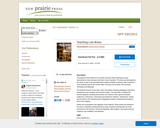
The purpose of this textbook is to provide resources about teaching low brass instruments to music educators and future music educators. The book was developed by the author as part of the open/alternative textbook initiative at Kansas State University. It Is the textbook used for the Kansas State University course Music 239-Low Brass Techniques and Materials.

Welcome to the exciting world of technical theatre. Studying this topic can lead to many different careers in several different sectors of the economy. The general skills needed for any of the careers or sectors have many things in common. Workers need to be dead-line oriented, as most productions have firm timelines that cannot be altered. Critical thinking and analysis are much needed skills. Almost every project in the field is unique and technicians and designers alike must discover the best way of reaching a project’s goal. Creative problem solving is trait successful practitioners have in common. With every project being unique, there are no guaranteed solutions to the problems that are presented. Technicians draw on their vast experience of what worked in the past that can be adapted to be a solution to the current problems. Clear communication and collaboration round out the necessary skills. No technical theatre project is ever handled by one person on their own. Collaboration with many people is the norm, and successful collaboration requires clear written and verbal communication skills.
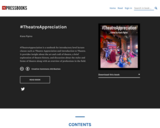
Short Description:
#TheatreAppreciation is a textbook for introductory level lecture classes such as Theatre Appreciation and Introduction to Theatre. It provides insight about the art and craft of theatre, a brief exploration of theatre history, and discussion about the styles and forms of theatre along with an overview of professions in the field.
Word Count: 97105
(Note: This resource's metadata has been created automatically by reformatting and/or combining the information that the author initially provided as part of a bulk import process.)
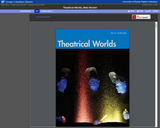
From the University of Florida College of Fine Arts, Charlie Mitchell and distinguished colleagues from across America present an introductory text for theatre and theoretical production. This book seeks to give insight into the people and processes that create theater. It does not strip away the feeling of magic but to add wonder for the artistry that make a production work well.

This workbook is a practical method for learning the rudiments of music, which are essential to a thorough understanding of music in general. Designed as a supplement to professional instruction rather than a manual for self instruction, the text is intentionally brief. The emphasis is on using practical exercises to develop fluency. Aural, vocal, and keyboard skills must be integrated into the study of music theory from the very beginning. I encourage all students, regardless of their principal instrument, to learn to hear, sing, and play on the piano everything that they do in theory. All exercises in this book should be completed thoroughly. Usually a sample will be completed in brackets for each exercise, as a demonstration. Fluency with these basic materials of music will be a great asset to any further musical endeavors. For students who need additional exercises, suggestions for further study will be given.
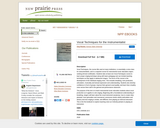
Vocal Techniques, the course title used at many institutions, is essentially a voice class for instrumentalists, and is a required course for instrumental music education majors seeking all-level certification. Students take at least one Vocal Techniques course to learn proper singing technique along with basic pedagogy and can include teaching techniques as they apply to adolescent singers. The focus of the course is the development of the individual singing voice. This includes breathing, tone production, articulation, musicality and textual expression and understanding. Students also develop confidence in front of groups, improve their general vocal quality, and learn that a healthy voice serves them well in the general and performance classroom.